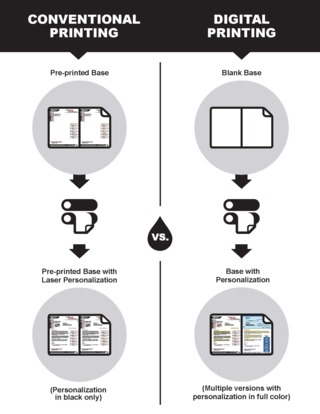Five Lessons Learned When Moving from Hybrid Conventional to White Paper Production
The purchase order you write for a continuous digital machine represents only a portion of the investment needed.

I’ve been quoted many times as saying, “Buying the press is the easiest part of transitioning from conventional to digital print.” That wisdom came with the installation of IWCO Direct’s first continuous digital press in 2011, the first step in the transition from a hybrid process that uses conventional print for color and static copy and offline monochrome laser or inkjet for variable content. Over the next six years, we added 11 boxes and continued to learn what matters most as technology changed and options for equipment became numerous. When making the transition from the hybrid conventional world to a white paper production environment/continuous digital environment, here are the five most important considerations to assure a smooth learning curve and quick startup.
1. Be cognizant of how your pressroom environment will change when you transition to a white paper production environment.
2. Be ready to invest in new workflow tools.
3. Be aware of color management requirements.
4. Be able to educate customers about designing for production inkjet.
5. Be prepared to change your selling strategy.
A white paper production environment needs a clean facility
The purchase order you write for a continuous digital machine represents only a portion of the investment needed. You may also need to invest in a new pressroom with attributes that include climate control, dust control, and humidity control. In addition, you’ll need clean power because of the advanced electronics that drive this platform. Google “climate control for digital press” and you’ll find press releases that describe installations that include, “construction of a brand new pressroom that will feature both ergonomic design and climate control to protect staff and equipment and paper stock.” It’s clear that if you can’t support the air quality requirements for these devices, you should not make the investment in this technology.
Conventional workflow tools won’t work in a white paper production environment
Trying to adapt your hybrid conventional workflow for continuous digital is like trying to use your grandfather’s standard wrench and socket set to change the oil in your Toyota. You risk stripping a bolt head when you try to make an old tool work on a new engine. When you invest in a continuous digital device, you also need to update your design, composition, layout, and proofing tools. It’s not just the workflow that changes. Traditional prepress management of desktop activities and assets is moving to the content development world as you move from printed shells and basic composition to unlimited versions created with dynamic content. Canon Solutions America just published a great book on this subject called, “Inkjet Workflow: How to Make Your Work Flow… Efficiently.”
Changes in ink and paper require a new approach to color management
Your transition from conventional to digital print will require a new vocabulary to talk about color. “Color gamut” will roll off operators’ tongues as if they’ve always used that term in their pressroom. You’ll quickly learn a new way of doing color builds in order to get the quality your customers expect. Inksets are dramatically different in this environment and paper becomes part of the color equation. While many will argue that the brightness and finish of paper for conventional print has an impact on reproduction quality, the process is not as susceptible to shifts in hue that occur in the digital world from the fluorescence of special inkjet papers.
Customer education is key to a successful grand opening of your white paper production environment
As I said at the beginning, the easiest part of transitioning to a white paper production environment is buying the press. The second easiest is getting clients excited about using the latest technology. But this is a clear case of “buyer beware.” You must be prepared to educate clients about how to design for production inkjet or the files you receive may result in big brown blobs instead of the desired pleasing color they were hoping for.
Designers need to understand how to create builds for the digital environment, how to optimize files with proper use of images and fonts, what to test, and what to avoid. Equipment manufacturers report the most common failure points remain the use of low resolution images and including data outside the printable area. Low resolution images (under 200 dpi) work perfectly when reproduced online but look awful when printed. For a quick and easy read about designing for this platform, request a copy of “The Designer’s Guide to Inkjet” from Canon Solutions America.
A new selling strategy is needed to fill your white paper production environment with work
Making the transition from a hybrid conventional environment to a white paper production environment requires more than tips and tactics. You must develop a sales strategy to introduce this technology. The strategy must promote the benefits and educate clients to manage expectations about a number of things including what’s needed to transition from conventional print to digital, how long that takes, what will ensure success, and how to seamlessly move from pre-printed shells with offline personalization to variable data to dynamic content.
It’s clear that we are witnessing a revolution in printing that has removed the barrier of static content and turned a white piece of paper into a digital canvas. Learning the five lessons provided here will help ensure your clients create masterpieces of marketing on this canvas.
Bio note after article: (like the April IWCO feature)
Dave Johannes is senior vice president of operations at IWCO Direct, where he manages content development, digital printing, and research and development. He is an expert in color digital workflow, printing, and technology and is co-founder of thINK, an independent community of Canon Solutions customers. He is also a frequent speaker, panelist, and case study presenter at industry events. He can be reached at [email protected].

